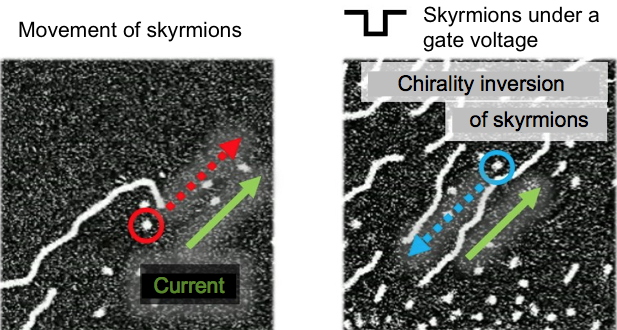Skyrmions are magnetic quasi-particles, of nanometric to micrometric lateral size, composed of spins that roll up in a given direction, this rolling Skyrmions are magnetic quasi-particles, of nanometric to micrometric lateral size, composed of spins that wind up in a given direction, this winding direction being called chirality. In magnetic films of nanometric thickness, if one passes radially through these skyrmions, the spins rotate 360° in a cycloid (
Figure 1). The skyrmions can be moved in the direction of the electric current or in the opposite direction depending on their chirality. Until now, their chirality was fixed "by construction" according to the nature of the multilayer materials in which they were observed. Researchers from our institute [collaboration] have succeeded in controlling in situ and locally the direction of motion of skyrmions by modifying their chirality using an applied gate voltage. Their results are published in the journal
Nature Communications.
 Figure 1: Top view representation of spins in skyrmions of opposite chirality: on the outside the spins exit the sheet (in red), on the inside they enter towards the sheet (in blue). The spins in the surrounding wall (green) rotate clockwise or counterclockwise when the skyrmion is crossed radially.
Figure 1: Top view representation of spins in skyrmions of opposite chirality: on the outside the spins exit the sheet (in red), on the inside they enter towards the sheet (in blue). The spins in the surrounding wall (green) rotate clockwise or counterclockwise when the skyrmion is crossed radially. From a fundamental point of view, these results are interpreted as the change of sign of an interfacial interaction at the origin of the chirality of skyrmions (the so-called Dzyaloshinskii-Moriya interaction, much studied in the framework of the physics of thin-film materials). From an application point of view, it is a first step towards the possibility of controlling the displacement of individual skyrmions with a low energy consumption method, which is essential to be able to use them as coding units (memory) or in logic gates.
The skyrmions have been studied in a nanometer thick multilayer system (Ta/FeCoB/TaO
x), typical of spintronic devices. The thickness of the ferromagnetic layer in which the skyrmions appear and the degree of oxidation of the adjacent oxide are parameters to be refined very precisely. The researchers fabricated a sample with a gradient of ferromagnetic layer thickness along one dimension and of oxidation along the other in order to determine the best combination, this know-how being available only in a few spintronics centers in the world, including the Spintec laboratory of our institute. A systematic study was then carried out to find the electrical parameters leading to the inversion of the motion. Figure 2 shows a magneto-optical microscopy image in which we observe the skyrmions (white dots) and their direction of motion in the initial material. Under the application of a gate voltage, the multilayer material is modified; in particular the displacement of some oxygen ions modifies the oxidation state of the interface with the ferromagnetic layer, and the new skyrmions obtained move in the opposite direction with respect to the first ones, due to an inversion of their chirality.
 Figure 2: Magneto-optical microscopy images illustrating, by the dotted arrows, the change in the direction of motion of the skyrmions (white dots) under the same current (continuous green arrow). (a) skyrmions in the initial material, (b) skyrmions under a gate voltage. The size of the images is about 50 µm.
Figure 2: Magneto-optical microscopy images illustrating, by the dotted arrows, the change in the direction of motion of the skyrmions (white dots) under the same current (continuous green arrow). (a) skyrmions in the initial material, (b) skyrmions under a gate voltage. The size of the images is about 50 µm.
Credit: Spintec (CNRS - CEA - Université Grenoble Alpes) These experiments are accompanied by simulations to predict the magnetic configuration at the nanoscale: they explain the results in relation to more fundamental physics concepts such as interfacial magnetic interactions. For future applications in spintronics, the next step is a fine control of the propagation of smaller (nanoscale) skyrmions, with the objective of being able to direct, in a reversible way, a chosen skyrmion in a desired direction. The researchers are starting to work on the integration of skyrmions in a patterned device (magnetic track) and to develop in parallel a model to deeply understand the physics mechanisms that control the movement of skyrmions under current.
Collaboration: This work was carried out in collaboration with the Institut Néel of Grenoble and the Laboratoire des sciences des procédés et des matériaux of Villetaneuse (CNRS).